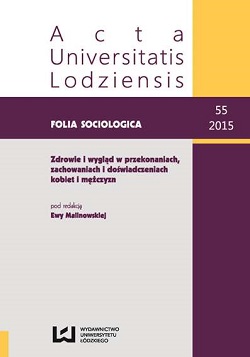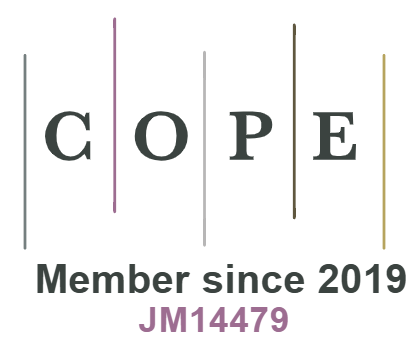Physical activity and health status among young people – preliminary report
DOI:
https://doi.org/10.18778/0208-600X.55.12Keywords:
physical activity, healthAbstract
According to the WHO definition, good health is a state of complete physical, social and mental well-being, and not merely the absence of disease or infirmity. The factors that significantly determine the human health status are health-related behaviors (including physical activity). The aim of this study was to evaluate the relationship between self-assessment of health status and physical activity among young women and men under 30 years of age. Research tool consisted of two parts – an author-made questionnaire for self-assessment of health status and description of physical activity and Brief Inventory of Thriving (BIT). The research was conducted in the period February–April in 2015 on a group of 368 respondents. Physically active people better assess their health status than physical inactive persons. Self-assessment of health status is higher among men than among women. Physically active people are more often happy and full of energy and less often feel fatigue.
References
Aktywność fizyczna Polaków (2013), Komunikat z badań BS/129/2013, CBOS, wrzesień.
Google Scholar
Biała księga (2007), Biała księga: Strategia dla Europy w sprawie zagadnień zdrowotnych związanych z odżywianiem, nadwagą i otyłością, Komisja Wspólnot Europejskich, KOM 279.
Google Scholar
Branca F., Nikogosian H., Lobstein T. (2007), The challenge of obesity in the WHO European Region and the strategies for response, World Health Organization.
Google Scholar
Campbell K. L., McTiernan A. (2007), Exercise and biomarkers for cancer prevention studies, “Journal of Nutrition”, Vol. 137, s. 161–191.
Google Scholar
DOI: https://doi.org/10.1093/jn/137.1.161S
Drabik J. (1996), Aktywność fizyczna w treningu zdrowotnym osób dorosłych, cz. II, AWF, Gdańsk.
Google Scholar
Drygas W., Jegier A., Bednarek-Gejo A., Kwaśniewska M., Dziankowska-Zaborszczyk E., Kostka T. (2005), Poziom aktywności fizycznej jako czynnik warunkujący występowanie otyłości i zespołu metabolicznego u mężczyzn w wieku średnim. Wyniki wieloletnich badań prospektywnych, „Przegląd Lekarski”, nr 62 (supl. 3).
Google Scholar
Drygas W., Piotrowicz R., Jegier A., Kopeć G., Podolec P. (2008), Aktywność fizyczna u osób zdrowych, „Polskie Forum Profilaktyki Chorób Układu Krążenia (PFP)”, nr 3 (12), październik, s. 1–2.
Google Scholar
Friedenreich C. M., Orenstein M. R. (2002), Physical activity and cancer prevention: etiologic evidence and biological mechanisms, “Journal of Nutrition”, Vol. 132 (supl. 11), s. 3456–3464.
Google Scholar
DOI: https://doi.org/10.1093/jn/132.11.3456S
Gajewska O., Bryła M., Maniecka-Bryła I. (2012), Samoocena stanu zdrowia uczestników zajęć Stowarzyszenia Uniwersytetu Trzeciego Wieku, „Hygeia Public Health”, Vol. 47 (4), s. 453–459.
Google Scholar
Global health risks (2009), Global health risks: mortality and burden of disease attributable to selected major risks, Geneva, World Health Organization.
Google Scholar
Konstytucja Światowej Organizacji Zdrowia (1946), Porozumienie zawarte przez Rządy reprezentowane na Międzynarodowej Konferencji Zdrowia i Protokół dotyczący Międzynarodowego Urzędu Higieny Publicznej, Nowy Jork, 22 lipca.
Google Scholar
Korporowicz V. (2008), Promocja zdrowia. Kształtowanie przyszłości, Oficyna Wydawnicza SGH, Warszawa.
Google Scholar
Maniecka-Bryła I., Bryła M. (2004), Samoocena stanu zdrowia oraz stanu psychicznego studentów Uniwersytetu Medycznego w Łodzi, „Zdrowie Publiczne”, Vol. 114 (4), s. 524–531.
Google Scholar
Sawada S. S., Muto T., Tanaka H., Lee I. M., Paffenbarger R. S. Jr, Shindo M., Blair S. N. (2003), Cardiorespiratory fitness and cancer mortality in Japanese men: a prospective study, “Medicine and Science in Sports and Exercise”, Vol. 35, s. 1546–1550.
Google Scholar
DOI: https://doi.org/10.1249/01.MSS.0000084525.06473.8E
Schnohr P., Lange P., Scharling H., Jensen J. S. (2006), Long-term physical activity in leisure time and mortality from coronary heart disease, stroke, respiratory diseases and cancer. The Copenhagen City Heart Study, “European Journal of Cardiovascular Prevention and Rehabilitation”, No. 13, s. 173–179.
Google Scholar
DOI: https://doi.org/10.1097/01.hjr.0000198923.80555.b7
Sport i aktywność fizyczna (2009), Badanie specjalne Eurobarometru nr 334, seria badawcza 72.3, „TNS Opinion & Social”, październik, s. 8–9.
Google Scholar
Stan zdrowia (2011), Stan zdrowia ludności Polski w 2009 r., GUS, Warszawa.
Google Scholar
Wojtyła A., Kapka-Skrzypczak L., Paprzycki P., Diatczyk J., Bylina J. (2011), Zachowania zdrowotne młodzieży. Raport, Instytut Medycyny Wsi, Lublin.
Google Scholar
Woynarowska-Sołdan M., Węziak-Białowolska D. (2012), Samoocena zdrowia i dbałość o zdrowie u nauczycieli, „Problemy Higieny i Epidemiologii”, nr 93 (4), s. 739–745.
Google Scholar
Wróblewska W. (2010), Samoocena stanu zdrowia, „Wiadomości Statystyczne”, nr 4, s. 36–53.
Google Scholar
Wytyczne UE (2008), Wytyczne UE dotyczące aktywności fizycznej, Zalecane działania polityczne wspierające aktywność fizyczną wpływającą pozytywnie na zdrowie. Czwarty projekt skonsolidowany, zatwierdzony przez Grupę Roboczą UE „Sport i Zdrowie”, 25 września, s. 3.
Google Scholar
Downloads
Published
How to Cite
Issue
Section
License
Copyright (c) 2015 © Copyright by Sylwia Kiełbasa, Natalia Kaźmierczak, Joanna Kwiatkowska, Antoni Niedzielski, Łódź 2015; © Copyright for this edition by Uniwersytet Łódzki, Łódź 2015

This work is licensed under a Creative Commons Attribution-NonCommercial-NoDerivatives 4.0 International License.










